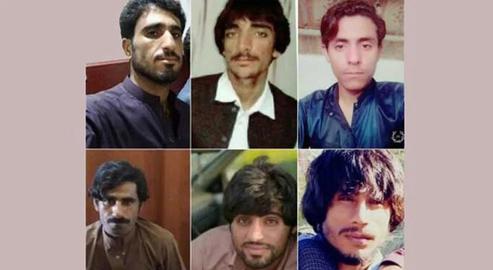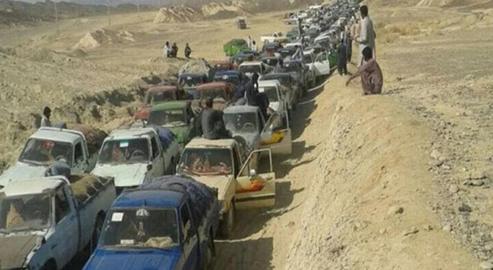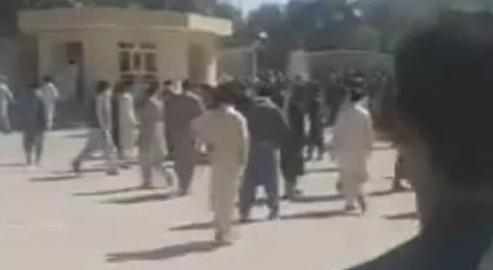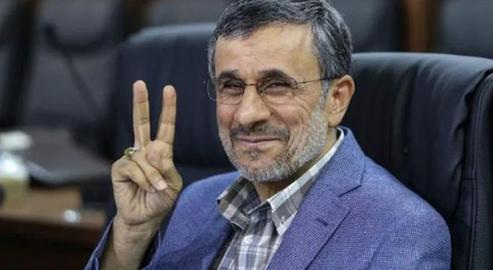Pictures published on social media, which have since been confirmed by local sources, show that today, Tuesday, February 23, protesters in Saravan in Sistan and Baluchistan broke into the governor's office and took control of the building.
Since yesterday, images of the bloodied seats of burning cars, and videos depicting the sound of gunshots and a police car on fire, have been posted online. These are sights and sounds that have rarely been seen in Iran, at least not since the end of the bloody protests in November 2019.
How and why did the fires of protest in Saravan ignite? And who is to blame?
***
On Monday, February 22, local media outlets in Sistan and Baluchistan province released videos of members of the Revolutionary Guards forces firing on impoverished local Baluch fuel smugglers, reportedly killing and injuring dozens of people.
The shootings began after a number of Baluch fuel smugglers, who convey fuel across the border in a desperate bid to secure an income for themselves, gathered in front of the IRGC’s base of operations at the zero point of the Askan border in the city of Saravan. They demanded the reopening of the border and permission to travel.
Border guards of the Islamic Republic have previously tried to block these penniless fuel smugglers by closing the border and digging large holes along the boundary line. The gathering of these locals was met this time by open fire by the Sistan and Baluchistan Revolutionary Guards, known as Mersad, after which the situation escalated at a record pace.
According to the Baluch Activists Campaign, at least 10 Baluch fuel smugglers were killed and many more were injured in the incident. Following the shootings, Baluchistan human rights news platforms reported severe shortages of blood supplies at Saravan’s Razi Hospital. News also surfaced of internet disruptions in Saravan and the cutting-off of communication channels with the city.
Mohammad Hadi Marashi, deputy governor of security and law enforcement for Sistan and Baluchistan, confirmed the incident but said the shooting was carried out by Pakistani border guards due to a "crowd rushing to the border." This version of events was denied by local sources and eyewitnesses in the Saravan region, who emphatically state it was the Revolutionary Guards who opened fire.
The severity of the incident on Monday sparked street protests and attacks on government and military bases on Tuesday morning. Since this morning, pictures and videos of the streets of Saravan indicate widespread tension and physical clashes have erupted. In one of the videos, angry citizens are seen breaking into the Saravan governor's office and taking control of the building.
The Baloch Activists Campaign wrote that security forces fired on the protesters "with plastic and exercise bullets" to disperse them. It claimed that a number of protesters had been injured by gunfire and tear gas but did not say whether any demonstrators had been killed.
Deputy Governor Marashi also confirmed the attack on the Saravan governor's office, saying that some people had been dispersed after "breaking the governor's office windows". He accused the Jaish al-Adl group, a jihadist organization, and unidentified "profiteers" of disrupting the Razzagh Plan: a strategy recently designed to regulate fuel consumption in border areas of Iran. The tensions in Saravan, he said, were nothing but "sabotage" by "counter-revolutionary groups".
According to the Razzagh Plan, refueling stations will be built along the border and the sale of fuel will be legalized and regulated. Baluch activists say the plan has recently sparked unrest as it could result in large populations in Sistan and Baluchistan losing their main source of income.
Videos of a police vehicle being set on fire in Saravan have also been posted online. The Baluch Activists Campaign has also reported that protesters were approaching the IRGC's Quds Force base in Saravan earlier today.
Reactions to Saravan events
In one of the first reactions to the events in Saravan, Molavi Abdul Hamid, the Sunni Friday Imam of Zahedan, issued a statement condemning the shooting of Baluch fuel smugglers, calling it against the law and the Sharia. "Fuel carrying is not a crime, or else it is not smuggling," he said. "The fuel carriers are the breadwinners of their families, and this is how thousands of families are able to survive."
In his statement, Molavi Abdul Hamid also called those who were killed in the Saravan attack “martyrs” and blamed "big fuel traders" for the current situation in Sistan and Baluchistan.
Iranian social media users have also protested against the brutal repression and killing of Baluch fuel smugglers with hashtags such as #Bloody_Saravan and #Saravan_is_not_alone. The Human Rights Organization of Iran also condemned the massacre of the Baloch people in a statement on Tuesday, February 23, and warned against violent suppression of protests in the province.
A Policy of Repression in Baluchistan
The firing of Islamic Republic border guards on fuel carriers, who are always termed fuel smugglers by the government, is a long-documented atrocity. Dozens of mostly Baluch citizens are killed each year in Sistan and Baluchistan, Kerman and Hormozgan, and most of them are people selling and transport fuel. However, the scale of this particular incident and the reaction of the citizens of Saravan are significant.
In recent years, the Islamic Republic has tried to prevent Baluch citizens from expressing their deep dissatisfaction with the dire economic situation and disregard for their political rights by pursuing a policy of repression and executions in Sistan and Baluchistan. The majority of the citizens of Sistan and Baluchistan province are also Sunni Muslims. Human rights reports going back 40 years show that religious and ethnic minorities in the Islamic Republic have always faced systemic discrimination, and these citizens are no different.
According to the Iranian Human Rights Organization, at least 22 Baluch prisoners have been executed in the past six months. There are currently about 124 prisoners on death row in Zahedan Central Prison. The unprecedented protests of the past two days in Saravan, which are still ongoing, have shown that these brutal policies have done nothing to quell the dissatisfaction of Baluch citizens or their hunger for change.
Related coverage:
Iranian Baluchis Protest Against the Shooting of Impoverished Fuel Smugglers
Wave of Executions of Baluch Iranians Horrifies Campaign Groups
Unemployment, Poverty and Executions in Iran’s Baluchistan Province
visit the accountability section
In this section of Iran Wire, you can contact the officials and launch your campaign for various problems



























comments